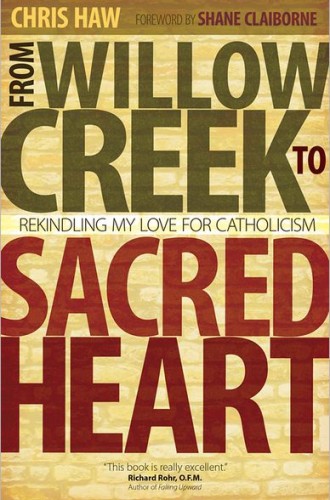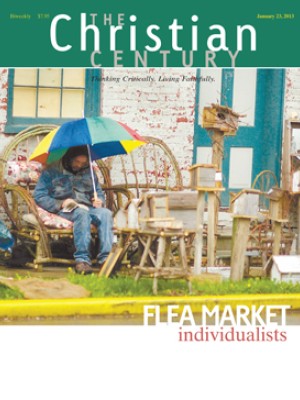From Willow Creek to Sacred Heart, by Chris Haw
My first thought upon learning that Chris Haw had written a memoir about his journey to Catholicism was, Oh no—not another one.
Back when I was moving toward Rome myself, I read a lot of conversion memoirs. Some were classics like John Henry Newman’s Apologia Pro Vita Sua and Thomas Merton’s Seven Storey Mountain. Others were contemporary apologies by fundamentalist Protestants turned fundamentalist Catholics who felt compelled to set their former coreligionists straight. Many were written by men (not women) who, like G. K. Chesterton, knew exactly what was wrong with the world. Many combined a romantic and ahistorical view of the glories of Rome with a craving for absolute authority. I did not want to read another book of that genre.
But after a few minutes with From Willow Creek to Sacred Heart, I could tell that Haw is no fundamentalist. He worries about military spending and environmental pollution. He is involved with urban community development. He is coauthor, with Shane Claiborne, of Jesus for President: Politics for Ordinary Radicals. An ordinary radical and social activist writing about his newfound love of Catholicism? This might be worth reading.
Read our latest issue or browse back issues.
Here’s a bird’s-eye view of Haw’s story: his mother, who taught religious education classes in her Catholic parish, took him to mass every Sunday until he was partway through middle school, when it occurred to her that the parish’s youth group was pretty lame. She had heard that there was a fantastic youth program at a nondenominational megachurch a short drive away:
With legions of staff and volunteers, Willow’s youth branch of the church . . . could entertain teens, teach them, summer camp them, mentor them, and exhaust them until they fell over in giddy excitement. Their youth ministry was replete with its own separate services, “relevant” songs, speeches, topics, dramas, videos, games, retreats, and so on. On any given Sunday over one thousand students would pour in. So, we went. And then we kept going.
Haw was entranced by the slick programming. He found support, friendship and intellectual stimulation from the youth leaders. He attended countless religious services, listened to piles of recorded sermons, began leading “worship events” himself and went on a short-term mission trip to the Dominican Republic. Eventually he was rebaptized, fancying himself “emerging from the waters of old religion and parental obligation into the world of choice, freedom, and self-determination.”
Enter adolescent angst. Haw’s youth group began making forays into Chicago’s mean streets. They held serious discussions about economic class, sweatshops, corporate greed and the United States’ role in Central American violence. Full of idealism, Haw enrolled at Eastern University, a Philadelphia-area school with a reputation for caring about social justice, and began protesting against homelessness, hunger, poverty, war and apathy. But when the Twin Towers crumbled, his faith was badly shaken—not so much by the terrorists as by the evangelical community’s distressing “silent consent for post 9/11 bellicose patriotism.”
Fortunately, Haw was soon distracted from his brooding. He joined a creation-care study program in the rain forests of Belize. He voraciously read Wendell Berry. He discovered several Anabaptist communities who were “practicing peace, redeeming enemies, and living more ecologically and sustainably.” And then he met Father Michael Doyle, an aging Vietnam War protester now in charge of Sacred Heart parish in decaying and dangerous Camden, New Jersey. Haw was blown away, not only by the way the church was meeting great needs in the city but also by its sacraments, rituals and feast days. Impulsively, he moved to Camden. And that’s the end of part 1, “Action (with Some Contemplation).”
Part 2, “Contemplation (with Some Action),” takes place mostly in Haw’s head. It is peopled with writers more than friends: John A. T. Robinson and Rudolf Bultmann give him new eyes for mystery, Friedrich Nietzsche and René Girard help him understand violence and scapegoating, John Dominic Crossan and Jack Miles sharpen his view of scripture, John of the Cross and Teresa of Ávila model faithfulness in a difficult church. And everywhere, everywhere, G. K. Chesterton: Haw quotes him, paraphrases him, leans on him and sometimes (“in short . . .”) even writes like him.
I could have done with less Chesterton, but Haw’s chosen topics haunt anyone who has inhabited or toured both sides of the Tiber. Why is the mass called a sacrifice? Why is there so much paganism in Catholic ritual? Isn’t mutual tolerance better than denominationalism? Shouldn’t the Vatican sell its holdings and give the proceeds to the poor? On the other hand, doesn’t Catholic art and literature make the world more livable? And isn’t the liturgy breathtakingly beautiful? Yet how in heaven’s name can people in their right mind join (or stay in) an authoritarian church that stands by while children are molested? Haw explores such topics thoughtfully and graciously, usually steering clear of new-convert triumphalism.
Unfortunately, however, he seldom links his theological musings to the events of his personal journey. He does not describe his confirmation. He does not divulge his feelings leading up to or following his decision to return to Rome; nor does he say how it affected his family and friends. He tells us little about his fellow war protester Cassie, who became his wife. He does not examine their undoubted concerns about bringing up their small son in a city with one of the highest crime rates in the nation.
Haw is similarly silent about what surely must be an important intellectual building block of his new identity: Catholic social teaching. Though he works on behalf of the poor and defends the rule of bishops, he never mentions that ever since Leo XIII’s groundbreaking encyclical Rerum novarum (1891), official Catholic documents have repeatedly and insistently promoted justice—though he allows that, sometimes, official Catholic actions subvert it.
Nevertheless, in one area Haw does an exceptionally fine job of uniting theology, personal narrative and contemporary social realities. When he describes liturgy, his writing comes alive. The mass, he writes, is “an attempt to remedy humanity by weekly gathering a potential lynch mob and habitually disarming them as they look upon the One whom they have murdered.” Kneeling before the cross on Good Friday, he grieves for Jesus, tortured and murdered in Jerusalem; for the tortured inmates of Abu Ghraib and Guantánamo Bay; and for his tortured and murdered neighbors in Camden. Then just before sunrise at the Easter Vigil—a celebration whose emotional intensity, Haw says, is “on par with witnessing the birth of my son”—light breaks into the darkness, choirs of angels sing, and the earth rejoices.
The bell tower joins our little bells as we emerge from the cellar-tomb and slowly process, behind a leader lifting a crucifix of the murdered God high, through the fragile and murder-ridden streets. Fellow friends and parishioners are revealed to be not mere mortals, but greeters in a great eschatological procession, . . . ushering us along the path into the cosmic banquet over which the tortured victim presides as the loving, forgiving host.
Willow Creek has a lot to offer, and Haw is grateful for his formation there. But he is head-over-heels in love with Sacred Heart. Even this post-Catholic reader, jaded by a surfeit of memoirs, finds his enthusiasm inspirational.






